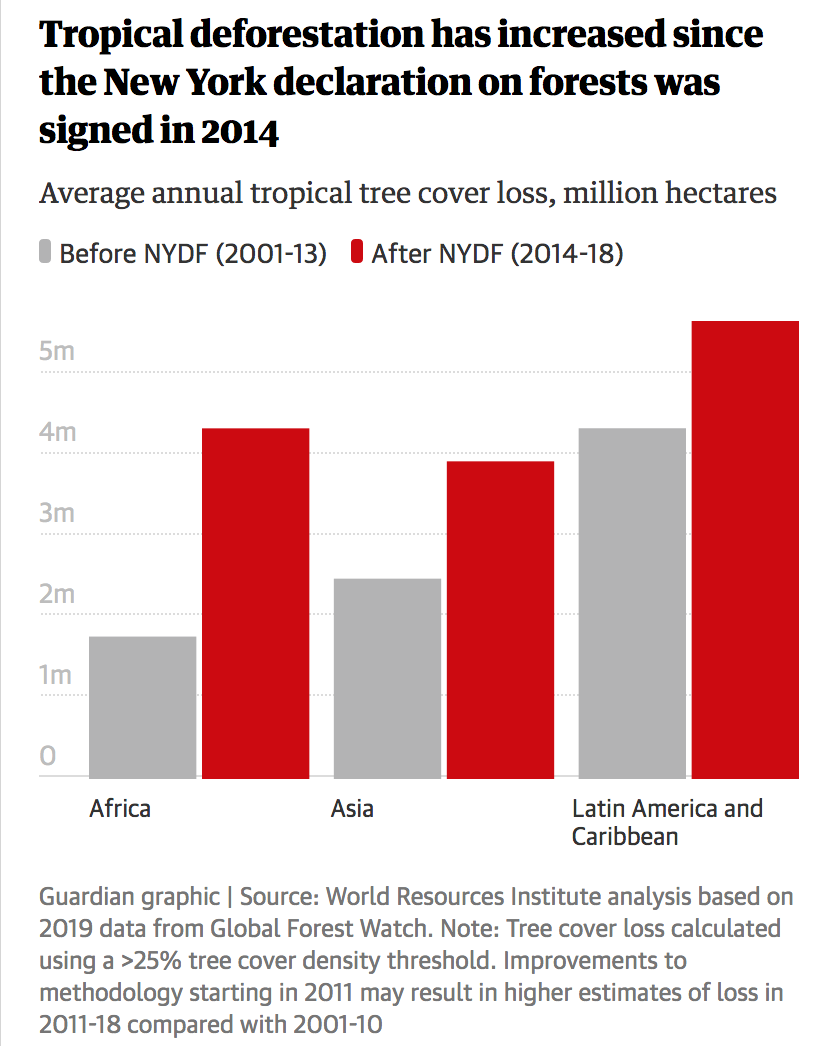By Fiona Harvey
An area of forest the size of the UK is being lost every year around the world, the vast majority of it tropical rainforest, with dire effects on the climate emergency and wildlife.
The rate of loss has reached 26m hectares (64m acres) a year, a report has found, having grown rapidly in the past five years despite pledges made by governments in 2014 to reverse deforestation and restore trees.
Charlotte Streck, a co-founder and the director of Climate Focus, the thinktank behind the report, said: “We need to keep our trees and we need to restore our forests. has accelerated, despite the pledges that have been made.”
The New York declaration on forests was in 2014, requiring countries to halve deforestation by 2020 and restore 150m hectares of deforested or degraded forest land.
But the rate of tree cover loss has gone up by 43% since the declaration was adopted, while the most valuable and have been cut down at a rate of 4.3m hectares a year.
The ultimate goal of the declaration, to – potentially saving as much carbon as taking all the world’s cars off the roads – now looks further away than when the commitment was made.
In Latin America, south-east Asia, and Africa – the major tropical forest regions – the annual rate of tree cover loss increased markedly between 2014 and 2018, compared with 2001 to 2013. While the greatest losses by volume were in tropical Latin America, the greatest rate of increase was in Africa, where deforestation rates doubled from less than 2m hectares a year to more than 4m.

The report uses data up to 2018 in most cases, so the figures do not include the impact of the most recent . The report’s authors note that in June, deforestation rates in the Brazilian Amazon rose by 88% compared with the same month last year.
Streck warned the recent fires were a particular concern because, whereas in previous decades when the humid nature of the rainforest made it hard to burn, with the lush vegetation acting as an effective firebreak, global heating in recent years has dried out parts of the forest and made it easier to combust.
“The fires are coming at the beginning of the dry season, which is when you would have expected the forests to be at their wettest and hardest to burn,” she said. “This shows we could be entering into a feedback loop.”

Feedback loops are because they amplify the effects of heating. In the case of forests, climate change dries out trees, making them more flammable, and increasing temperatures so they burn more easily, which then contributes more carbon dioxide, which fuels heating.
Keeping existing forests standing, particularly in tropical regions, and restoring wooded areas that have been damaged, has long been recognised as one of the cheapest ways of tackling the climate crisis. The cost of preserving key forests globally has been estimated to be in the of dollars a year, compared with the trillions needed to .
Jo House, a reader in environmental science and policy at the University of Bristol, said: “Deforestation, mostly for agriculture, contributes around a third of anthropogenic CO2 emissions. At the same time, forests naturally take up around a third of anthropogenic CO2 emissions.
“This natural sink provided by forests is at risk from the duel compounding threats of further deforestation and future climate change. The continued loss of primary forests, at ever-increasing rates, despite their incalculable value and irreplaceability, is both shocking and tragic.”
One of the difficulties highlighted by the report is that of gaining private sector support and investment for keeping forests standing. While there are clear economic benefits to cutting down forests, in the form of timber production and expanded agriculture, there are few investments being made in keeping existing forests healthy.
Another complicating factor is that many governments , which provide perverse incentives for deforestation.

The report from a coalition of 25 organisations is being presented in New York before a series of events focusing on the climate crisis in the run-up to the UN secretary general’s summit later this month. At the meeting, world leaders are expected to come up with new proposals for tackling the climate emergency.
But Streck said the failure to meet the pledges made five years ago undercut the value of such promises if they were not backed up with finance, detailed plans and on-the-ground implementation.
“We don’t need more important guys standing up making pledges,” she said. “We need to go beyond declarations. Implementation is complicated, but it’s what we need.”
There have been some bright spots. The rate of loss of primary forest in Indonesia slowed by nearly one-third between 2017 and 2018. Palm oil plantations in the country are a major cause of deforestation, but companies and the government have from consumers and aid donors. Wetter weather that reduced forest fires also helped.
While some countries have embarked on tree-planting schemes, , but also in Mexico and El Salvador, these have been far outweighed by the loss of existing forests. Tree planting does not compensate for the loss of standing forests, because established growth yields benefits beyond carbon uptake, through the whole ecosystem.
“It can take centuries for forests to recover their full carbon-absorbing and weather-regulating capabilities,” Streck said.
Source: The
Related to SDG 13: Climate action



